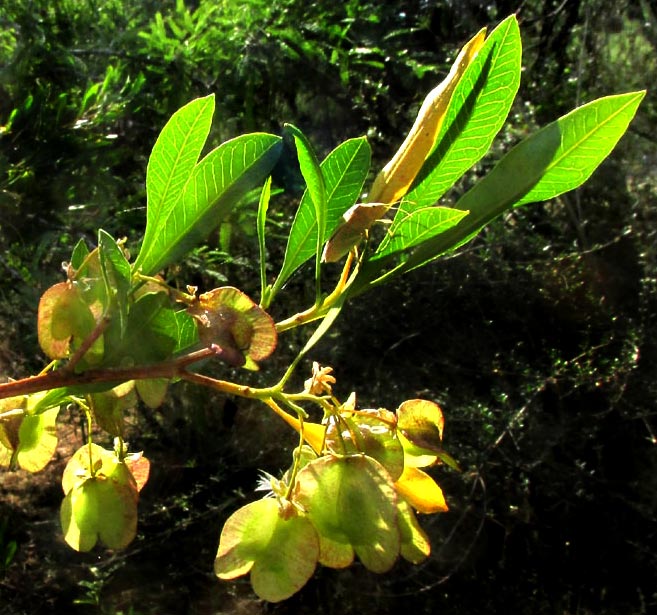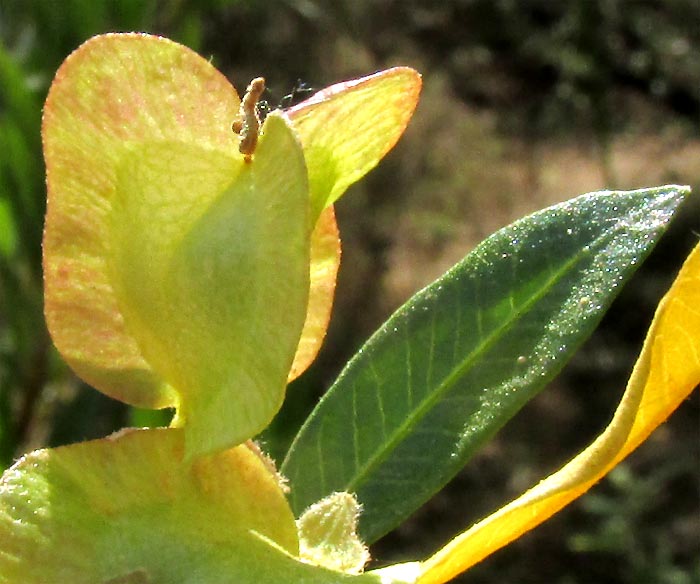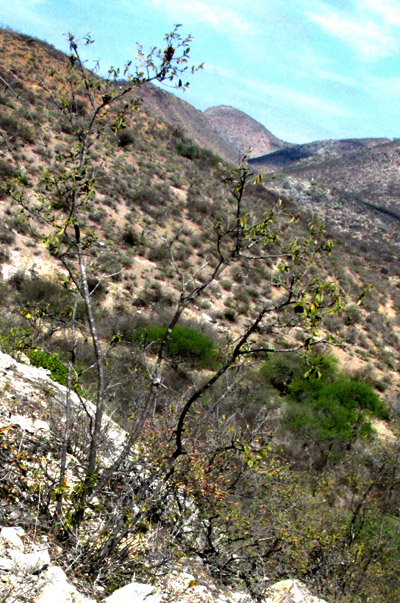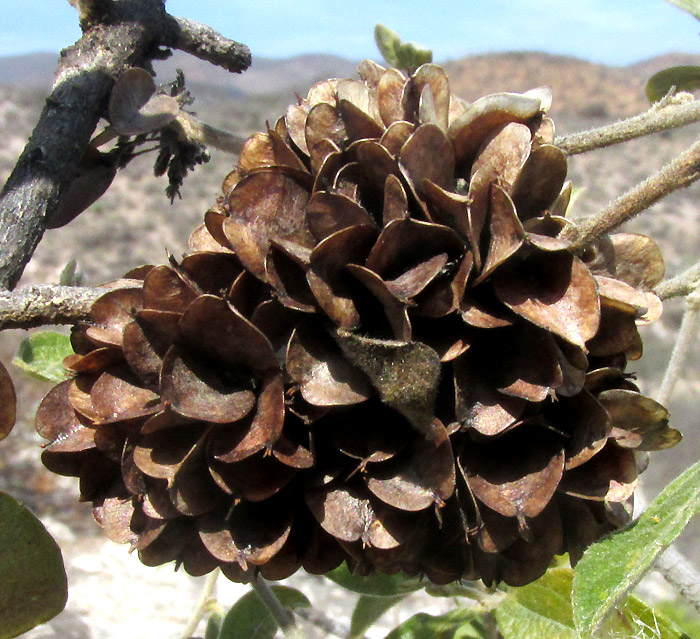Excerpts from Jim Conrad's
Naturalist Newsletter
entry dated May 5, 2022, issued from near Tequisquiapan, elevation about 1,900m (6200 ft), ~N20.57°, ~ W99.89°, Querétaro state, MÉXICO
HOPBUSH FRUITING

Both growing wild in gully bottoms where the effects of the current driest part of the dry season are less harsh, as well as planted along village streets as shade trees, a certain kind of tree about 3m tall (10ft) nowadays is producing the curious three-winged, capsular fruits shown above. Below is a close-up of a fruit:

This fruit develops from a fairly normal looking ovary, one that's usually divided into two or three compartments, or locules. Each locule develops its own wing, which helps with wind distribution. In the above picture, the small, curvy, brown thing atop the fruit consists of dried-up stigma lobes.
I'd seen three-winged fruits suggestive of Hopbush's, for example on the Balloon-Vine, and ballon-vine species are members of the Soapberry Family, the Sapindaceae. When I looked into that family, in our area only one species is arboreal with simple leaves, and that's the Hopbush, DODONAEA VISCOSA. Hopbush isn't to be confused with Hops, which are vines in the Hemp Family, the Cannabinaceae.
The Hopbush species is very flexible with its sexual preferences. Some trees bear flowers producing both male and female parts, while others produce only unisexual male or female flowers. In fact, this species thrives where humans have disrupted the natural environment because it is flexible and adaptive in many ways. Not all Hopbushes look alike. For a long time botanists debated whether Hopbush was represented by several distinct species in different parts of the world and in different environments, or just one enormous, exceedingly variable species, or something in between. Nowadays with genetic sequencing, such questions needn't go unanswered.
In 2009, Mark G. Harrington and P. Gadek, trying to understand the evolutionary history of Hopbush, published results of their genetic studies in an article entitle "A species well travelled - The Dodonaea viscosa (Sapindaceae) complex based on phylogenetic analyses of nuclear ribosomal ITS and ETSf sequences." They concluded that the species evolved in Australia during the Early Pleistocene, or early ice age, about 2 million years ago, then somehow spread to all continents except Antarctica. They propose that Dodonaea viscosa be recognized as an "ochlospecies." Ochlospecies are those displaying large amounts of variation that can't be correlated with geography or ecology. The variants may be consistently distinguishable locally, but not globally.
Though Hopbush is only a small tree, its wood is tough and durable. In New Zealand it's the heaviest of any native wood, and the Māori traditionally used it for making weapons, carved walking staves, axe-handles, and weights on drill shafts. In other places Hopbush's leaves have been mashed and applied as plasters for wounds. However, here no such uses are documented.
Entry dated March 9, 2024, from notes taken about 2kms west of Higuerillas, Municipality of Cadereyta de Montes; N20.9086°, W99.7865°, elevation ~1760 meters (~5760 feet); on greywacke sandstone cap of hill; area constituting a narrow belt of the extreme southern extension of the Chihuahuan Desert, Meridional Subregion; central Querétaro state, MÉXICO
HOPBUSH FRUITING, WILD APPEARANCE

The small tree shown above isn't much like the Hopbushes growing in towns. I didn't recognize it until a cluster of three-winged capsular fruits was noticed:

At a distance, the cluster looked like a pine cone. However, when it was touched, it shattered into individual capsules:

Even the newly emerged leaves had a different color and texture:

It's easy to see how in the past some taxonomists recognized new Hopbush species which now are regarded as mere forms of one very variable species. As described in the previous entry, the study "A species well travelled... " shows that our Hopbush is an "ochlospecies" -- one displaying large amounts of variation which can't be correlated with geography or ecology.
Being an ochlospecies appears to be a wise survival strategy, for Hopbushes arose relatively recently during the evolution of Life on Earth. However, once it was on the scene, it spread rapidly across the planet, into many different habitats.